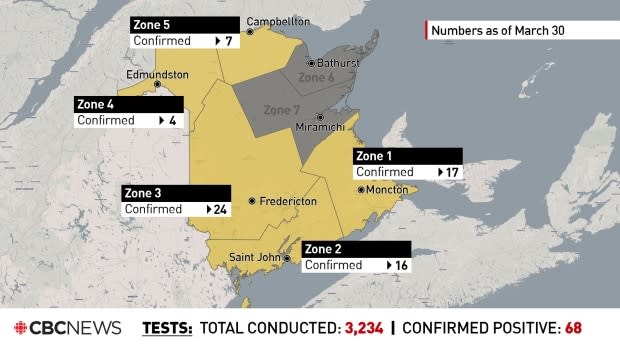COVID-19 testing data reveal areas of concentration, missing info in New Brunswick

Heavy testing in the Moncton area, lesser amounts elsewhere and missing data for many — perhaps all — provincial regions were the highlights of an hour-long briefing for reporters Wednesday on the current state of testing for COVID-19 in New Brunswick.
Dr. Jennifer Russell, the province's chief medical officer of health, and René Boudreau, an associate deputy minister with the Department of Health, attempted to give more detailed numbers on where the province has been concentrating its hunt for the COVID-19 virus.
But, in some instances, the information added more confusion than clarity.
The province had completed 3,234 tests for COVID-19 as of Monday, but missing residency information on 577 of the test results — more than one in six — clouded a detailed accounting of exactly where testing has been concentrated.
"Some of them are not known," said Boudreau about the 577 tests done by the province that do not have an address attached.
"For some, the postal code was illegible or the place where the person lives was not known."
Boudreau did say the province has records of 359 tests being done in the two northeastern health zones which have no recorded cases of the virus yet, including 121 tests in zone 7 around Miramichi and 238 in zone 6, which runs from Bathurst up through the Acadian Peninsula.
That is 11 per cent of the total tests completed in the province for an area that has 16 per cent of the provincial population. However, the missing data made it difficult to know if testing numbers in the region are complete.
One issue that was made clear is the most extensive testing to date has been done in the Moncton region (zone 1).
It had at least 1,005 tests completed as of Monday, more than double the 460 done in the Saint John region (zone 2) even though it serves only 16 per cent more people.
Moncton results were also 70 per cent higher than the 586 tests recorded in the Fredericton region (zone 3).
The Moncton region contains a little more than 27 per cent of New Brunswick's population but so far accounts for 38 per cent of the COVID-19 tests done — at least those with known addresses.
Testing Data (Source: Public Health) Zone 1 1,005 Zone 2 460 Zone 3
586
Zone 4 182 Zone 5 65 Zone 6
238
Zone 7 121 Unknown 577 Total 3,234
The first case in New Brunswick was recorded in the Moncton region, and Boudreau said heavy testing in one area over another is a function of when cases first appear and the hunt that triggers for associated cases.
"Those early cases drive a lot of exponential testing because we go after the 30 close contacts of the first case and let's say that gives us six new cases, we go after the 30 next ones of those six," said Boudreau.
But, according to the province's official COVID-19 website Monday, all of that testing in the Moncton area turned up fewer cases of COVID-19 (17) than the much smaller testing efforts in either Fredericton (22) or Saint John (18).

Another oddity revealed was that the fewest tests per capita so far have been done in the Campbellton region (zone 5), even though it has the highest concentration of cases for its size in the province. Boudreau said only 65 tests have been carried out there despite six or seven positive results so far.
The technical briefing and the government website gave different numbers for confirmed tests in three of the seven zones, including Campbellton's zone 5, but with only 28,000 residents, even six cases are more than double the provincial average per capita.
At the end of the technical session a government spokesperson said the province is preparing to publish a lot of the numbers around testing in New Brunswick on Tuesday but needed some time to recheck some of the information it was presenting.
"We always want to double and triple check these numbers that are fluid and, in some cases, unfortunately get readjusted occasionally," he said.


